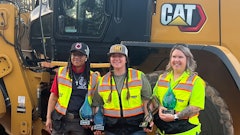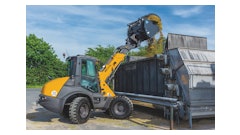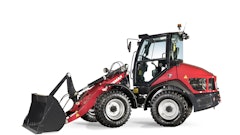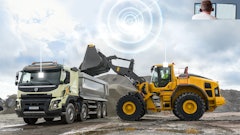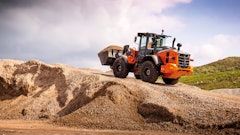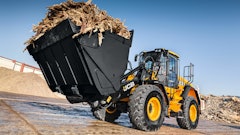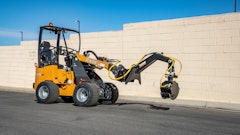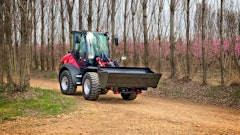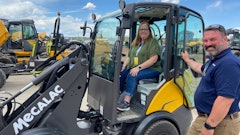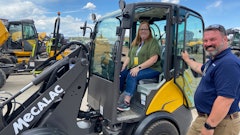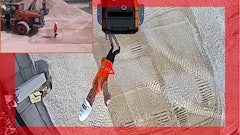
If you're telling yourself and your customers that there's no need for compact wheel loaders — skid steers can do any job — you're likely steering your customers in the wrong direction.
Certainly, the versatility of skid steers is difficult for any machine to top. But, no one can be the best at everything. When it comes to being the best at loading and unloading materials, compact wheel loaders achieve the best performance. After all, that's what they are designed for, although they too can multi-task with the help of different attachments.
Because compact wheel loaders are still relatively new to the United States, manufacturers often find themselves needing to explain where exactly compact wheel loaders fit in.
"I think a big misconception is that skid loaders can do the same things that compact wheel loaders do," says Brian Rabe, product specialist, excavators/all-wheel-steer loaders at Gehl Co. While skid steer and compact wheel loader applications parallel one another, compact wheel loaders offer advantages in rental applications that can't be beat.
A top performer
Compact wheel loaders can lift about double what skid steers can lift. While a skid steer might have a tipping load of 3,000 to 3,800 pounds, a compact wheel loader might have a tipping load of 7,300 to 7,400 pounds, notes Eric Winkler, marketing manager, New Holland.
In addition to strong lift capacities, David Wolf, marketing manager for Case Construction Equipment, says compact wheel loaders offer high break-out forces and good reach heights.
They also have faster cycle times and increased travel speeds, says Michael Ross, national product and training manager for Takeuchi Manufacturing.
In fact, some manufacturers offer a high-speed travel option of about 20 miles per hour.
Easy to get along with
Operating compact wheel loaders is relatively simple. They make a novice proficient and an experienced operator even better, says Wolf.
A single-lever loader control has the forward/reverse control mounted to it so an operator need not move his hand from the controls, making it an easy and comfortable machine to operate, says Dave Hardwick, heavyline product marketing manger at JCB Inc.
"It's basically like getting into your car and using one lever to move the boom up and down and to roll the buckets forward and backwards," Winkler says. "It's very easy and much easier than using a skid steer."
Rabe adds, "It's very simple for somebody who has never run that piece of equipment to get in there and be productive right off the bat."
In addition to being easy to use, other operator benefits include better visibility and comfort, which in turn improve worksite safety, Wolf says.
Being able to operate a machine easily and safely encourages repeat rentals and helps prevent machine damage while the machine is out of the rental shop.
Valuable outputs
Hardwick says compact wheel loaders are used on jobsites not only because of their compact size, but also because they offer the lowest cost option to move material, as they have high outputs but rent for less than a full-size loader. Or, he adds, "because they need to be moved regularly and trailer requirements limit machine size."
Other machines can move material, but Hardwick emphasizes compact wheel loaders are designed specifically for this task. "While offering the ultimate efficiency, they ensure machine durability as they are designed for continuous loading applications," he says.
Rabe points out that compact wheel loaders, while larger than skid steers, have smaller engines that require less horsepower, which saves fuel and helps prevent engine wear and tear. Tires on wheel loaders also last longer because they turn, they don't skid, he says.
Although the initial investment might be higher for a rental business, he says lower owning and operating costs make compact wheel loaders a wise investment.
While skid steers might have a life expectancy of three to four years, Winkler says larger, more rugged components of compact wheel loaders, along with good maintenance practices, lead to a machine with a much longer life expectancy.
Hard-working
Applications for compact wheel loaders closely mirror applications for skid steers:
- contractors working in landscaping, demolition or recycling, road construction, residential or commercial construction, and agriculture.
Compact wheel loaders are especially helpful for load and carry applications, digging, and handling palletized material, says Wolf.
"They're not machines that you're going to be doing a lot of grading work with," Ross says. "They are machines for moving dug material quickly and efficiently."
Looking specifically at the rental market, Hardwick says someone likely to rent a compact wheel loader is a contractor with a specific task that requires compact size. For example, someone needing to load out demolition waste in an urban location could benefit from a compact wheel loader.
Loading and unloading dump trucks is an example of the compact wheel loader at its best.
"I think often people use the much bigger equipment, but that's kind of overkill," Ross says. "You can use a much bigger wheel loader and certainly not have to load your bucket quite as often, but it's not as maneuverable as the compact machine."
At lawn and garden centers, compact wheel loaders can lend a hand. "It's great if somebody comes in and wants to buy a yard and a half of mulch," Ross says. "You've got a bucket that can handle that and it's quick and easy."
A benefit to landscapers and construction workers, compact loaders turn and create significantly less turf damage than skid steers. If a finished jobsite allows for only minimal damage to an existing landscape, Rabe says a compact wheel loader is the best machine for the job.
"A lot of the jobsites out there are getting smaller and smaller," Ross says. "Residential homes often are built on smaller lots with limited space between homes. Many new homes between 2,000 and 3,000 square feet are being built on ¼- to 1/2–acre lots. Commercial businesses will often be built on even smaller lots. Typically, these buildings will have minimal landscaping and tight spaces between the decorative trees they plant and the sidewalks, parking lots and buildings. When you add air conditioning units, the space available for maneuvering equipment gets even smaller.
Compact wheel loaders that are 66 to 82 inches wide and articulate in the center can be used to maneuver between buildings and around corners because the rear tires follow the same track as the front tires. You don't have to worry about the rear end of the machine swinging into a building or around a corner."
Versatile vessels
To add versatility, compact wheel loaders can be equipped with attachments, including some of the same attachments used with skid steers.
Attachment examples include: rock buckets, earth augers, snow pushers, snow blades, loader booms, power rakes, tree spades, bale huggers, bale spikes and silage defacers.
Ross suggests attaching:
- An oversize bucket for snow removal, or sand moving and backfilling
- A broom for cleaning up the street after running trucks in and out of a jobsite
- A grapple attachment to grab recyclables for loading on a truck or conveyor belt
When using skid steer attachments, Hardwick notes that not all skid steer attachments are suitable for the greater power that compact loaders can apply. "The user must check the data plate carefully to confirm the maximum capacities of these attachments," he emphasizes.
With or without attachments, if compact wheel loaders can't do the job, they can be used to bring in other equipment because
most compact loader models offer hitches, Rabe points out.
The long haul
A top performer that's easy to get along with, valuable, hard-working and versatile could be a good fit for any rental fleet.
"As margins shrink, contractors will look harder at the costs of rental equipment on the job and the lowest cost machine that can do the job will become the unit of choice," says Hardwick. "Often a compact loader is capable of doing the job currently utilizing a full-size loader while minimizing the cost of the rental. For the rental company the ROI is more attractive but only if there is a demand for this type of machine from customers."
Rabe predicts compact wheel loaders will show continued growth and more versatile attachments will follow customers' needs in new applications.
While versatility is in high demand, speed and efficiency also are key, Ross reminds.
"The quicker you can get in and move the material, the more efficiently you can move the material, the more money the contractor (and rental shop owner) can put in his pocket."
Whether looking at compact wheel loaders or other machines, Winkler suggests, "Look for new opportunities with new equipment. Reevaluate the types of equipment you're using. There might be something around the corner that could actually make you more money in the long haul."
Gehl 80-Series All-Wheel-Steer Loaders
- 280, 480, 480T (telescopic) and 680 feature "intelligent drive" technology, which automatically reduces speed and increases tractive effort when driving into a pile
- Four-wheel steering and one-piece chassis allow for added maneuverability, stability and tractive power
- Operating weights from 7,055 to 12,015 lbs.
- Bucket capacities from 1.44 to 2.35 cu. yds.
- Rated operating loads from 2,590 to 4,365 lbs.
- EPA Tier II diesel engines range from 38 to 76 hp
Mustang All-Wheel Steer Loaders
- ML28, ML48, ML48T (telescoping boom) and ML68 AWS loaders feature a redesigned body and operator compartment
- Load stabilizer enables carrying a full bucket at up to the optional 25-mph maximum speed (12 mph standard)
- Redesigned cab features pilot controls, more air vents and increased overall operator visibility
- Quick-hitch attachment system
- Optional EcoSpeed system provides a two-speed transmission
Ingersoll Rand Compact Loaders
- 60-hp WL-350 has an 11,240-lb. operating weight and a 1.2-cu.-yd. bucket
- 73-hp WL-440 has a 13,230-lb. operating weight and a 1.4-cu.-yd. bucket
- Parallel loader linkage allows for 10,128- and 12,730-lb. breakout force and maintains the load position parallel to the ground throughout the lift range
- Hydrostatic drivetrain technology
- Limited-slip differential axles
- Transverse-mounted engine and rear-mounted hydraulic pump
- Hydraulic quick-coupler system
John Deere 344J Compact Loader
- 98-hp 344J compact wheel loader features oscillated stereo steering, which allows for tight turns with large loads
- Provides a 12,500-lb. static full-turn tipping load, 17,310 lbs. of breakout force and a 12-ft. reach
- Standard hydrostatic drivetrain with infinitely variable range and a high speed of 19 mph
- Features include a load-sensing, closed-center hydraulic system, standard return-to-dig feature and manual low-speed differential lock
Takeuchi Compact Loader Line
- TW50, TW60, TW65 and TW80 offer operating weights of approximately 8,700 to 12,600 lbs.
- Perkins or Deutz engines rated from 51 to 73 SAE gross hp
- 8,992 to 15,287 lbs. of breakout force
- +/- 12-degree frame oscillation and center pivot steering
- Hydrostatic drive system
- 100-percent front and rear differential lock
- Bucket float function and automatic bucket positioning
- Hydraulic quick attach
JCB Wheel Loaders
- Automotive-style cab with 105 cu. ft. of overall internal volume
- 2.75- to 4.6-cu.-yd. standard bucket sizes
- 13,070- to 30,890-lb. full-turn tipping loads
- Totally redesigned machine styling
- Revised cooling pack to improve access for cleaning
- Refined loader hydraulics with single-lever loader control valve• High-lift options on 426HT and 436HT models
- Optional Smooth Ride System








